从句类型-状语从句
- 格式:ppt
- 大小:117.00 KB
- 文档页数:18

英语状语从句归纳总结英语状语从句是英语语法中的一个重要部分,它可以用来修饰句子中的主谓宾成分,提供更多的信息和细节。
在学习英语状语从句时,需要掌握从句的类型和用法,以下是一些常见的英语状语从句类型及其用法。
1. 时间状语从句时间状语从句用来表示某个动作发生的时间或顺序。
一些常用的时间状语从句包括:when, while, as, after, before, since, until 等。
例如:- When I was young, I used to play basketball with my friends.(当我年轻时,我曾经和我的朋友们一起打篮球。
)- While I was cooking dinner, the phone rang.(当我在做晚饭的时候,电话响了。
)- After I finish this project, I will take a break.(当我完成这个项目后,我会休息一下。
)2. 地点状语从句地点状语从句用来表示某个动作发生的地点。
一些常用的地点状语从句包括:where, wherever, anywhere, everywhere等。
例如:- She always knows where her keys are.(她总是知道她的钥匙在哪里。
)- Wherever he goes, he takes his laptop with him.(无论他去哪里,他都带着他的笔记本电脑。
)3. 原因状语从句原因状语从句用来表示某个动作发生的原因。
一些常用的原因状语从句包括:because, since, as, now that等。
例如:- Because it was raining, we decided to stay indoors.(因为下雨了,我们决定呆在室内。
)- Since you didn't like the movie, we can watch something else.(既然你不喜欢这部电影,我们可以看其他的。
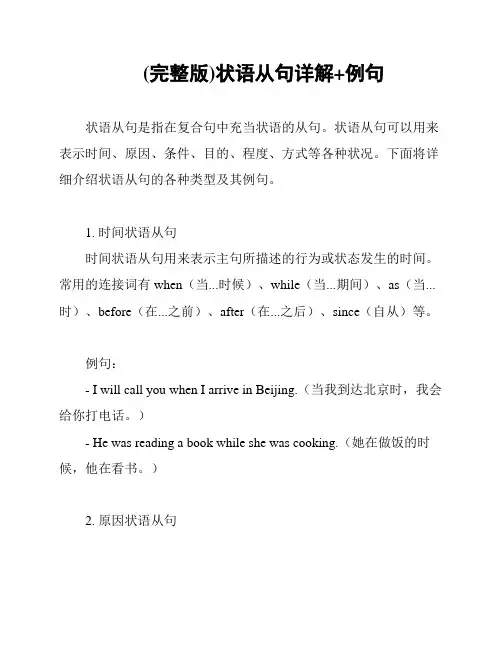
(完整版)状语从句详解+例句状语从句是指在复合句中充当状语的从句。
状语从句可以用来表示时间、原因、条件、目的、程度、方式等各种状况。
下面将详细介绍状语从句的各种类型及其例句。
1. 时间状语从句时间状语从句用来表示主句所描述的行为或状态发生的时间。
常用的连接词有when(当...时候)、while(当...期间)、as(当...时)、before(在...之前)、after(在...之后)、since(自从)等。
例句:- I will call you when I arrive in Beijing.(当我到达北京时,我会给你打电话。
)- He was reading a book while she was cooking.(她在做饭的时候,他在看书。
)2. 原因状语从句原因状语从句用来表示主句所描述的行为或状态的原因。
常用的连接词有because(因为)、since(因为)、as(由于)、for (因为)等。
例句:- I can't go to the party because I have to work.(我不能去参加派对,因为我得工作。
)- Since it is raining, we should stay at home.(由于下雨了,我们应该待在家里。
)3. 条件状语从句条件状语从句用来表示主句所描述的行为或状态的前提条件。
常用的连接词有if(如果)、unless(除非)、whether(无论)、provided(倘若)等。
例句:- If it rains tomorrow, we will stay indoors.(如果明天下雨,我们会呆在室内。
)- We can go shopping unless it is too late.(除非太晚,否则我们可以去购物。
)4. 目的状语从句目的状语从句用来表示主句所描述的行为或状态的目的。
常用的连接词有so that(以便)、in order that(为了)、lest(免得)等。
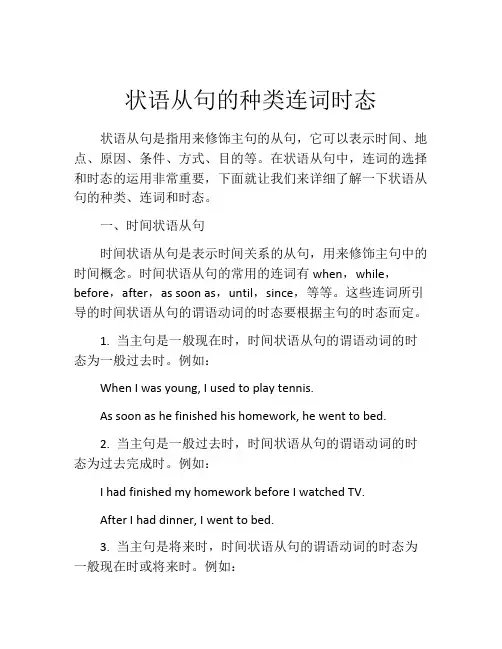
状语从句的种类连词时态状语从句是指用来修饰主句的从句,它可以表示时间、地点、原因、条件、方式、目的等。
在状语从句中,连词的选择和时态的运用非常重要,下面就让我们来详细了解一下状语从句的种类、连词和时态。
一、时间状语从句时间状语从句是表示时间关系的从句,用来修饰主句中的时间概念。
时间状语从句的常用的连词有when,while,before,after,as soon as,until,since,等等。
这些连词所引导的时间状语从句的谓语动词的时态要根据主句的时态而定。
1. 当主句是一般现在时,时间状语从句的谓语动词的时态为一般过去时。
例如:When I was young, I used to play tennis.As soon as he finished his homework, he went to bed.2. 当主句是一般过去时,时间状语从句的谓语动词的时态为过去完成时。
例如:I had finished my homework before I watched TV.After I had dinner, I went to bed.3. 当主句是将来时,时间状语从句的谓语动词的时态为一般现在时或将来时。
例如:I will call you as soon as I arrive in Shanghai.He will stay in New York until he finds a job.二、地点状语从句地点状语从句是表示地点关系的从句,用来修饰主句中的地点概念。
地点状语从句的常用的连词有where,wherever,等等。
这些连词所引导的地点状语从句的谓语动词的时态一般和主句保持一致。
例如:I will meet you where we agreed.Wherever you go, I will follow you.三、原因状语从句原因状语从句是表示原因关系的从句,用来修饰主句中的原因概念。
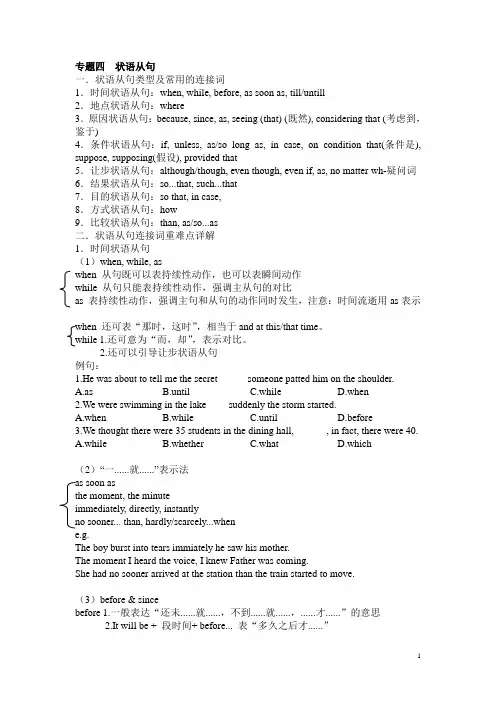
专题四状语从句一.状语从句类型及常用的连接词1.时间状语从句:when, while, before, as soon as, till/untill2.地点状语从句:where3.原因状语从句:because, since, as, seeing (that) (既然), considering that (考虑到,鉴于)4.条件状语从句:if, unless, as/so long as, in case, on condition that(条件是), suppose, supposing(假设), provided that5.让步状语从句:although/though, even though, even if, as, no matter wh-疑问词6.结果状语从句:so...that, such...that7.目的状语从句:so that, in case,8.方式状语从句:how9.比较状语从句:than, as/so...as二.状语从句连接词重难点详解1.时间状语从句(1)when, while, aswhen 从句既可以表持续性动作,也可以表瞬间动作while 从句只能表持续性动作,强调主从句的对比as 表持续性动作,强调主句和从句的动作同时发生,注意:时间流逝用as表示还可表“那时,这时”,相当于and at this/that time。
while 1.还可意为“而,却”,表示对比。
2.还可以引导让步状语从句例句:1.He was about to tell me the secret _____ someone patted him on the shoulder.A.asB.untilC.whileD.when2.We were swimming in the lake____ suddenly the storm started.A.whenB.whileC.untilD.before3.We thought there were 35 students in the dining hall, ______, in fact, there were 40.A.whileB.whetherC.whatD.which(2)“一......就......”表示法the moment, the minuteimmediately, directly, instantlyno sooner... than, hardly/scarcely...whene.g.The boy burst into tears immiately he saw his mother.The moment I heard the voice, I knew Father was coming.She had no sooner arrived at the station than the train started to move.(3)before & sincebefore 1.一般表达“还未......就......,不到......就......,......才......”的意思2.It will be + 段时间+ before... 表“多久之后才......”since 1.表“自从.......”从句一般用一般过去时,主句的时态一般为现在完成时或者现在完成进行时。
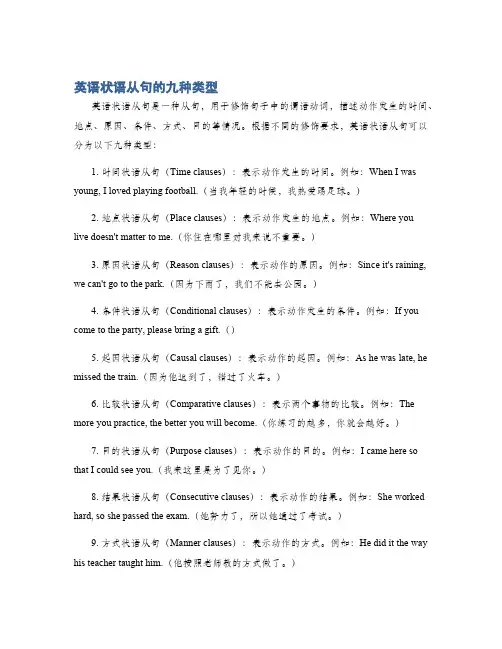
英语状语从句的九种类型英语状语从句是一种从句,用于修饰句子中的谓语动词,描述动作发生的时间、地点、原因、条件、方式、目的等情况。
根据不同的修饰要求,英语状语从句可以分为以下九种类型:1. 时间状语从句(Time clauses):表示动作发生的时间。
例如:When I was young, I loved playing football.(当我年轻的时候,我热爱踢足球。
)2. 地点状语从句(Place clauses):表示动作发生的地点。
例如:Where youlive doesn't matter to me.(你住在哪里对我来说不重要。
)3. 原因状语从句(Reason clauses):表示动作的原因。
例如:Since it's raining, we can't go to the park.(因为下雨了,我们不能去公园。
)4. 条件状语从句(Conditional clauses):表示动作发生的条件。
例如:If you come to the party, please bring a gift.()5. 起因状语从句(Causal clauses):表示动作的起因。
例如:As he was late, he missed the train.(因为他迟到了,错过了火车。
)6. 比较状语从句(Comparative clauses):表示两个事物的比较。
例如:The more you practice, the better you will become.(你练习的越多,你就会越好。
)7. 目的状语从句(Purpose clauses):表示动作的目的。
例如:I came here so that I could see you.(我来这里是为了见你。
)8. 结果状语从句(Consecutive clauses):表示动作的结果。
例如:She worked hard, so she passed the exam.(她努力了,所以她通过了考试。
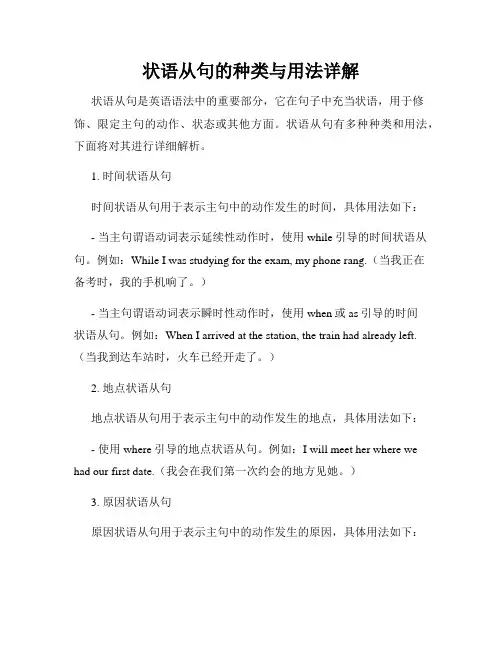
状语从句的种类与用法详解状语从句是英语语法中的重要部分,它在句子中充当状语,用于修饰、限定主句的动作、状态或其他方面。
状语从句有多种种类和用法,下面将对其进行详细解析。
1. 时间状语从句时间状语从句用于表示主句中的动作发生的时间,具体用法如下:- 当主句谓语动词表示延续性动作时,使用while引导的时间状语从句。
例如:While I was studying for the exam, my phone rang.(当我正在备考时,我的手机响了。
)- 当主句谓语动词表示瞬时性动作时,使用when或as引导的时间状语从句。
例如:When I arrived at the station, the train had already left.(当我到达车站时,火车已经开走了。
)2. 地点状语从句地点状语从句用于表示主句中的动作发生的地点,具体用法如下:- 使用where引导的地点状语从句。
例如:I will meet her where we had our first date.(我会在我们第一次约会的地方见她。
)3. 原因状语从句原因状语从句用于表示主句中的动作发生的原因,具体用法如下:- 使用because或since引导的原因状语从句。
例如:He couldn't come to the party because he had to work overtime.(他不能来参加聚会,因为他得加班。
)- 使用as引导的原因状语从句,强调两个动作同时发生。
例如:As the sun set, the sky turned orange.(太阳下山时,天空变成橙色。
)4. 条件状语从句条件状语从句用于表示主句中的动作发生的条件,具体用法如下:- 使用if或unless引导的条件状语从句。
例如:If it rains tomorrow, we will stay indoors.(如果明天下雨,我们将呆在室内。
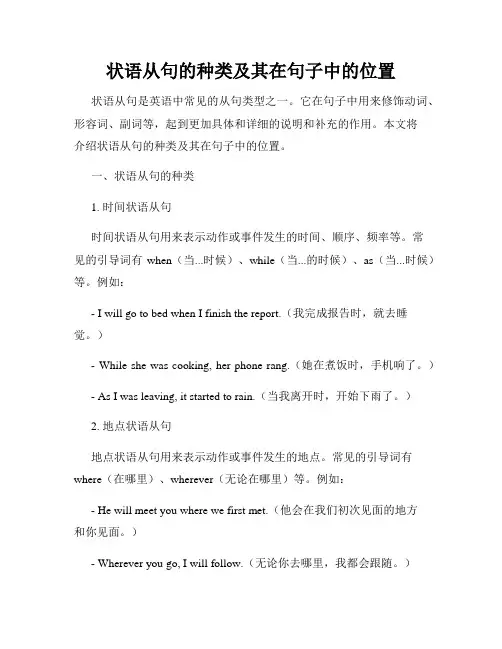
状语从句的种类及其在句子中的位置状语从句是英语中常见的从句类型之一。
它在句子中用来修饰动词、形容词、副词等,起到更加具体和详细的说明和补充的作用。
本文将介绍状语从句的种类及其在句子中的位置。
一、状语从句的种类1. 时间状语从句时间状语从句用来表示动作或事件发生的时间、顺序、频率等。
常见的引导词有when(当...时候)、while(当...的时候)、as(当...时候)等。
例如:- I will go to bed when I finish the report.(我完成报告时,就去睡觉。
)- While she was cooking, her phone rang.(她在煮饭时,手机响了。
)- As I was leaving, it started to rain.(当我离开时,开始下雨了。
)2. 地点状语从句地点状语从句用来表示动作或事件发生的地点。
常见的引导词有where(在哪里)、wherever(无论在哪里)等。
例如:- He will meet you where we first met.(他会在我们初次见面的地方和你见面。
)- Wherever you go, I will follow.(无论你去哪里,我都会跟随。
)原因状语从句用来表示动作或事件发生的原因。
常见的引导词有because(因为)、since(因为)、as(因为)等。
例如:- He didn't come to the party because he was sick.(他因为生病所以没有来参加派对。
)- Since it's raining, we should stay at home.(因为下雨了,我们应该待在家里。
)4. 目的状语从句目的状语从句用来表示动作或事件的目的。
常见的引导词有so that (以便)、in order that(为了)等。
例如:- I study hard so that I can pass the exam.(我努力学习,以便能通过考试。
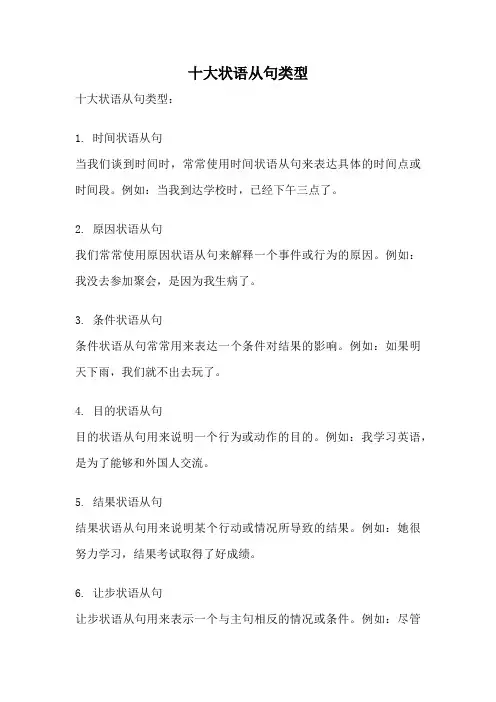
十大状语从句类型
十大状语从句类型:
1. 时间状语从句
当我们谈到时间时,常常使用时间状语从句来表达具体的时间点或时间段。
例如:当我到达学校时,已经下午三点了。
2. 原因状语从句
我们常常使用原因状语从句来解释一个事件或行为的原因。
例如:我没去参加聚会,是因为我生病了。
3. 条件状语从句
条件状语从句常常用来表达一个条件对结果的影响。
例如:如果明天下雨,我们就不出去玩了。
4. 目的状语从句
目的状语从句用来说明一个行为或动作的目的。
例如:我学习英语,是为了能够和外国人交流。
5. 结果状语从句
结果状语从句用来说明某个行动或情况所导致的结果。
例如:她很努力学习,结果考试取得了好成绩。
6. 让步状语从句
让步状语从句用来表示一个与主句相反的情况或条件。
例如:尽管
下雨了,但他还是出去跑步了。
7. 比较状语从句
比较状语从句用来表示两个或多个事物之间的比较。
例如:他比我更高大。
8. 方式状语从句
方式状语从句用来说明某个行动或动作的方式。
例如:他悄悄地走进房间。
9. 地点状语从句
地点状语从句用来说明某个行动或动作发生的地点。
例如:我们在公园里见面。
10. 比较状语从句
比较状语从句用来表示两个或多个事物之间的比较。
例如:她比我更聪明。
这是十大常见的状语从句类型,通过使用不同类型的状语从句,我们可以更加准确地表达我们的意思,使语言更加丰富多样。
同时,了解这些状语从句的用法也能够帮助我们更好地理解和使用复杂句子。

初中英语语法之状语从句类型及考点讲义状语从句概念解析状语从句指句子用作状语时,起副词作用的句子,可以修饰谓语、非谓语动词、定语、状语或整个句子,可分为时间、地点、原因、条件、目的、结果、让步、方式和比较等从句,是英语复合句学习的一个重点,在各类考试中都会经常出现,这次就来给大家讲解一下什么是状语从句。
1. 时间状语从句:常用引导词:when, as, while, as soon as, before, after, since , till, until特殊引导词:the minute, the moment, the second, every time, the day,the instant, immediately , directly, no sooner … than, hardly …when, scarcely … when instantlyI ran into the classroom as soon as the bell rang.2. 地点状语从句:常用引导词:where特殊引导词:wherever, anywhere, everywhereWherever the sea is , you will find seamen.3. 原因状语从句:常用引导词:because=in that, since=now that, as, for特殊引导词:seeing that, now that, in that, considering that, given thatI 'm late because I didn't caught the bus.4. 目的状语从句:常用引导词:so that, in order that特殊引导词: for fear that(唯恐/生怕),in the hope that, for the purpose that, to the end thatYou should book the hotel in advance so that the travel will be more easy.5.结果状语从句:常用引导词:so … that, such … that特殊引导词:such that, to the degree that, to the extent that, to such a degree thatHe is so young that he can't have meal by himself.6. 条件状语从句:常用引导词:if, unless,特殊引导词:as/so long as(只要), only if, providing/provided that(倘若), supposing that(倘若), in case that(以防), on condition thatYou can go to London as long as you have passport.7.让步状语从句:常用引导词:though, although, even if, even though特殊引导词: as(用在让步状语从句中必须要倒装),while,no matter …, in spite of the fact that, whatever, whoever, wherever, whenever, however, whichever, as if=as thoughThough we are old, we still can do these by ourselves.8. 比较状语从句:常用引导词:as(同级比较), than(不同程度的比较)特殊引导词:the more …the more …; just as …,so…,no … more than; not A so much as BShe is as pretty as her mother.9. 方式状语从句:常用引导词:as, as if, how特殊引导词:the wayHe didn't so it the way his brother did.辨析:while,when,as三者引导的时间状语从句时间状语从句算是状语从句中最简单的一类,也是我们日常生活交流中最常用的一类,虽然难度不大,但引导词也不少,仍然有不少同学会弄混那几个常见引导词的用法,这次就为大家带来as,when,while这几个词的辨析方法,一起看看吧。
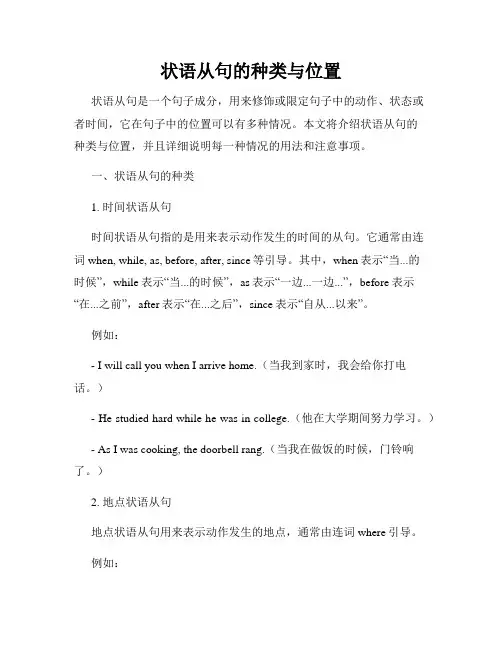
状语从句的种类与位置状语从句是一个句子成分,用来修饰或限定句子中的动作、状态或者时间,它在句子中的位置可以有多种情况。
本文将介绍状语从句的种类与位置,并且详细说明每一种情况的用法和注意事项。
一、状语从句的种类1. 时间状语从句时间状语从句指的是用来表示动作发生的时间的从句。
它通常由连词when, while, as, before, after, since等引导。
其中,when表示“当...的时候”,while表示“当...的时候”,as表示“一边...一边...”,before表示“在...之前”,after表示“在...之后”,since表示“自从...以来”。
例如:- I will call you when I arrive home.(当我到家时,我会给你打电话。
)- He studied hard while he was in college.(他在大学期间努力学习。
)- As I was cooking, the doorbell rang.(当我在做饭的时候,门铃响了。
)2. 地点状语从句地点状语从句用来表示动作发生的地点,通常由连词where引导。
例如:- He found a quiet place where he could concentrate.(他找到了一个安静的地方,可以集中精力。
)3. 原因状语从句原因状语从句用来表示动作发生的原因,通常由连词because, since, as, now that等引导。
例如:- She couldn't attend the meeting because she was sick.(她因为生病无法参加会议。
)- Since it's raining, we should bring umbrellas.(因为下雨了,我们应该带伞。
)- As I have finished my work, I can go out now.(因为我已经完成了工作,所以现在可以出去。
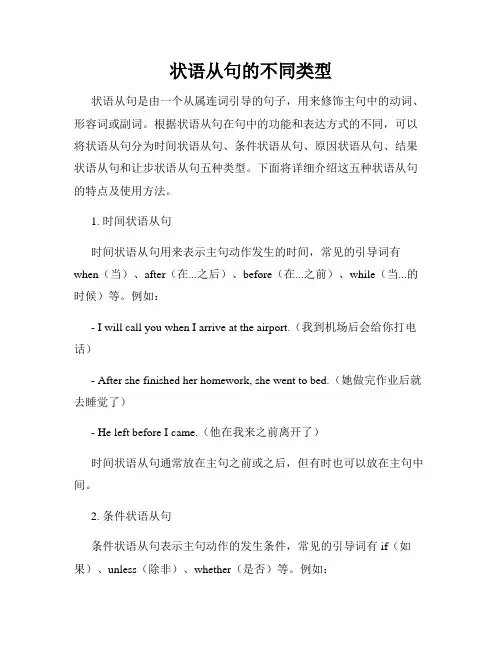
状语从句的不同类型状语从句是由一个从属连词引导的句子,用来修饰主句中的动词、形容词或副词。
根据状语从句在句中的功能和表达方式的不同,可以将状语从句分为时间状语从句、条件状语从句、原因状语从句、结果状语从句和让步状语从句五种类型。
下面将详细介绍这五种状语从句的特点及使用方法。
1. 时间状语从句时间状语从句用来表示主句动作发生的时间,常见的引导词有when(当)、after(在...之后)、before(在...之前)、while(当...的时候)等。
例如:- I will call you when I arrive at the airport.(我到机场后会给你打电话)- After she finished her homework, she went to bed.(她做完作业后就去睡觉了)- He left before I came.(他在我来之前离开了)时间状语从句通常放在主句之前或之后,但有时也可以放在主句中间。
2. 条件状语从句条件状语从句表示主句动作的发生条件,常见的引导词有if(如果)、unless(除非)、whether(是否)等。
例如:- If you study hard, you will pass the exam.(如果你努力学习,你会通过考试的)- Unless it rains, we will go for a picnic.(除非下雨,否则我们会去野餐)条件状语从句通常放在主句之前,但有时也可以放在主句之后。
3. 原因状语从句原因状语从句用来表示主句动作的原因或理由,常见的引导词有because(因为)、since(因为)、as(因为)、for(因为)等。
例如:- I stayed at home because I was sick.(因为生病了,我呆在家里)- Since you are busy, I will help you.(既然你很忙,我来帮你)原因状语从句通常放在主句之前。
高考英语语法复习:八种状语从句的用法状语从句状语从句有时间、地点、原因、目的、方式、结果、条件、让步等八种。
一、时间状语从句:引导词有after,before,as,once,since,till,until,when,whenever,while,as soon as,the moment/minute…(一…就),the time,the day,every time,next time,each time,by the time of,no sooner…than(一…就),hardly…when(一…就).例如:Each/Every time he comes here,he will drop in on me.每次他来这儿他都顺便看我.He was ill last time I saw him.上次我见到他时他病了.No sooner had she heard the news than she cried.她一听到这个消息就哭了.[辨析]when与whilewhen引导的从句动词可以是延续性的或短暂性的,while引导的从句中动词必须是延续性的;在“be…when…”句式中when表“at that time(就在这时)”意,这样用的when不能换为while;while有时并不表示时间,而表示对比,意“而”、“却”,when无这样的用法。
例如:When I got home I found the door locked./While(或When)we were working in the fields,it suddenly began to rain./He was wandering through the streets when a bike hit him./His pencil is red,while mine is yellow.[辨析]till与until一般情况下可以互换,但until可以位于句首,till则不能。
状语从句九大类型及例句一、时间状语从句1、从句中常用引导词:When, after, before, as, as soon as, till, until, while 等。
2、例句:When we got home, dinner was ready.二、条件状语从句1、从句中常用引导词:If, unless, provided, on condition that, as/so long as等。
2、例句:I will go out with you if you promise to be back by 10.三、地点状语从句1、从句中常用引导词:Where, wherever等。
2、例句:Where there's a will, there's a way.四、原因状语从句1、从句中常用引导词:Because, since, as, now that, now that等。
2、例句:He can't work since he is ill.五、结果状语从句1、从句中常用引导词:So that, so..that, such...that, that等。
2、例句:They worked so hard that they succeeded in the end.六、让步状语从句1、从句中常用引导词:Though, although, even though, whatever, whichever等。
2、例句:Though it rained heavily, the sports meeting went on.七、比较状语从句1、从句中常用引导词:Than, as, as...as, not so...as等。
2、例句:You ought to work harder than you do now.八、方式状语从句1、从句中常用引导词:As, as if, as though, like等。
9大状语从句用于增强语气和表达情感在英语语法中,状语从句是指用来修饰主句的复合句。
它可以起到修饰时间、地点、原因、条件、目的等各种作用。
状语从句的存在可以丰富语言表达,增强语气,表达情感而不单单是为了传达信息。
本文将探讨9种常见的状语从句,在日常写作和口语交流中的使用方法和意义。
1. 时间状语从句时间状语从句是用来描述主句和另一个时间点之间的关系。
常用的连接词有when, while, as, since, before, after, until等。
例如:- When I was young, I used to play the piano every day.- After I finish my work, I will go to the gym.时间状语从句可以用来强调时间关系,同时也可以让语言更加生动有趣。
另外,在写作和演讲中,恰当的使用时间状语从句可以帮助读者或听众更好地了解事件的发展情况。
2. 地点状语从句地点状语从句是用来描述主句和另一个地点之间的关系。
常见的连接词有where, wherever, anywhere等。
例如:- I will go wherever you go.- She looked everywhere for her missing cat.地点状语从句可以用来准确描述地点,增强表情。
尤其在描述旅游、故事或传记等方面,地点状语从句经常被使用.3. 原因状语从句原因状语从句是用来描述主句和某个原因之间的关系。
常见的连接词有because, since, as, for等。
例如:- Because it was raining, I stayed at home last night.- I don't like to eat fish, for I am allergic to it.原因状语从句可以强调某个事件的原因,增强语气。
通过使用原因状语从句,写作者或者说话人可以清晰地表达某个事情的原因,使文章更加步入事实,增强可信程度。
状语从句详解状语从句是复句中的一种从句,用来修饰动词、形容词、副词或整个句子。
它起到进一步说明、补充或限制主句的作用。
本文将详细解析状语从句的定义、分类、用法及注意事项。
一、状语从句的定义状语从句是一个从属分句,由连词引导,在主从句之间建立一种从属关系。
它通常修饰动词、形容词、副词或整个句子,用来表示时间、条件、原因、目的、方式、程度、比较等等。
通过引导词的不同,状语从句可以分为多种类型。
二、状语从句的分类1. 时间状语从句时间状语从句用来表示动作发生的时间,在主句中起到修饰的作用。
时间状语从句常用的引导词有:when(当)、while(当...时)、before (在...之前)、after(在...之后)、as(当...的时候)等等。
例如:- I will call you when I arrive home.(我到家后会给你打电话。
)- They went to bed after they finished their homework.(他们做完作业后就上床睡觉了。
)2. 条件状语从句条件状语从句用来表示主句发生的条件,在主句中起到修饰的作用。
条件状语从句常用的引导词有:if(如果)、unless(除非)、provided that(只要)、as long as(只要)等等。
例如:- If it rains, we will stay at home.(如果下雨,我们将待在家里。
)- You can go out unless it is too cold.(除非天气太冷,你可以出去。
)3. 原因状语从句原因状语从句用来表示主句发生的原因,在主句中起到修饰的作用。
原因状语从句常用的引导词有:because(因为)、since(因为)、as (因为)、for(因为)等等。
例如:- She didn't come to the party because she was sick.(她没有来参加聚会,因为她生病了。
1.时间状语从句(adverbial clauses of time),多由连词引起。
欧阳学文(when,after,before,as,as soon as,as longas,since,whenever,once)E.g. When we lived in town we often went to the theater.It was a long time before I got to sleep again.As the sun rose the fog dispersed(vt. 消散).少数不由连词引起状语从句。
(now that,every time,each time,themoment,immediately,instantly,directly)E.g. Directly he uttered(vt. 说出)these words, there eas a dead silence.I had no sooner checked in the hotel than he arrived.2.地点状语从句(adverbial clause of place)(where,wherever,anywhere)E.g. The church was built where there had once been a roman temple(n.寺庙).Everywhere I go, I find the same thing.3.方式状语从句(adverbial clause of manner),一般由as,like,as if引起。
E.g. I am as you can image short of money. 正如你能想象的那样,我很缺钱。
I did as she asked.Do it as he does.I feeljust like I did when I was a boy.I remember the whole thing as if it happened yesterday.He glanced about as if in search of something.4.原因状语从句(adverbial clause of reason), 一般由because,as,since,in case,还有两个词有相同的意思(seeing,considering)E.g. He was angry because we were late.As the soup was very salty, we were thirsty afterwards.He took a spoonful(n.满满的一勺) and tasted it in case it was hot.Seeing that it is ten o’clock, we shall not wait for her any longer.5.条件状语从句,一般由if,unless,supposing, providing,as long as, granted that引起。
英语句型分析之状语从句(完整版)状语从句⽤来修饰主句中的动词,副词和形容词的从句叫状语从句。
时间状语从句 when, whenever, while, as, before, after, since, till, once, as soon as,etc.地点状语从句 where,wherever原因状语从句 because, since, as, for, now that, etc.⽬的状语从句 in order that, so that, that, etc.结果状语从句 so…that, so that, such…that, that, etc.条件状语从句 if, unless, as(so)long as, etc.让步状语从句 though, although, even if, even though, however, whatever, as,etc.⽐较状语从句 as…as, so…as, than, etc.⽅式状语从句 as, as if, as though, etc1. 时间状语从句(1)时间状语从句常⽤when, as, while, before, after, since, till, until, as soon as等连词来引导。
e.g.It was raining hard when got to school yesterday.e.g.After he finished middle school, he went to work in a factory.在时间状语从句⾥,通常不⽤将来时态,⽤现在时态表⽰将来的动作或状态。
e.g.I’ll ring you up as soon as I get to New York.在带有till或until引导的时间状语从句的主从复合句⾥,如果主句⽤肯定式,其含义是“⼀直到……时”,谓语动词只能⽤延续性动词。